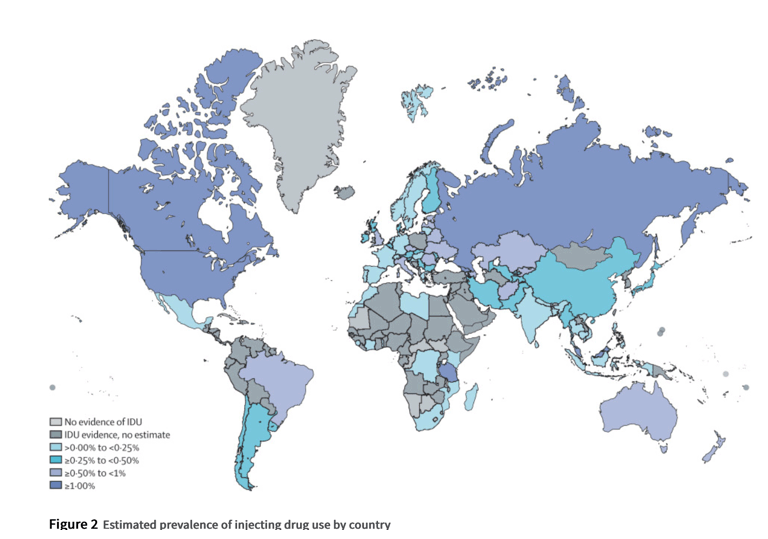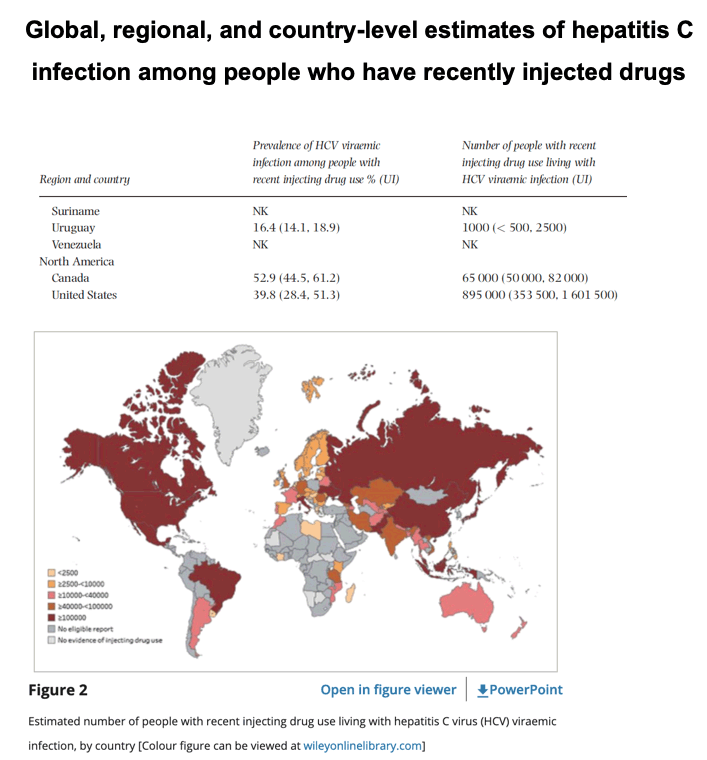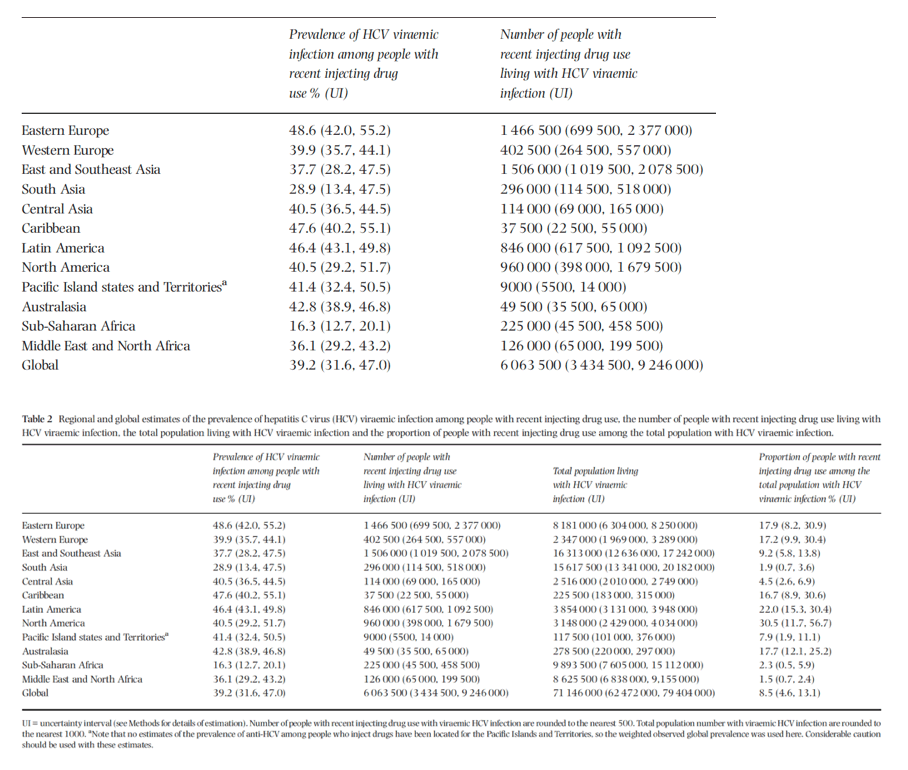| |
Global prevalence of injecting drug use and sociodemographic characteristics and prevalence of HIV, HBV, and HCV in people who inject drugs: a multistage systematic review
|
| |
| |
Download the PDF here
Download the PDF here
We estimate that there are 15⋅6 million (95% uncertainty interval [UI] 10⋅2-23⋅7 million) PWID aged 15-64 years globally, with 3⋅2 million (1⋅6-5⋅1 million) women and 12⋅5 million (7⋅5-18⋅4 million) men.
Estimated in US IDUs 2,248,500 (1,236,500 to 4,074,000)

Gender composition varied by location: women were estimated to comprise 30⋅0% (95% UI 28⋅5-31⋅5) of PWID in North America and 33⋅4% (31⋅0-35⋅6) in Australasia, compared with 3⋅1% (2⋅1-4⋅1) in south Asia. Globally, we estimate that 17⋅8% (10⋅8-24⋅8) of PWID are living with HIV, 52⋅3% (42⋅4-62⋅1) are HCV-antibody positive, and 9⋅1% (5⋅1-13⋅2) are HBV surface antigen positive; there is substantial geographic variation in these levels. Globally, we estimate 82⋅9% (76⋅6-88⋅9) of PWID mainly inject opioids and 33⋅0% (24⋅3-42⋅0) mainly inject stimulants. We estimate that 27⋅9% (20⋅9-36⋅8) of PWID globally are younger than 25 years, 21⋅7% (15⋅8-27⋅9) had recently (within the past year) experienced homelessness or unstable housing, and 57⋅9% (50⋅5-65⋅2) had a history of incarceration.
At a regional level, prevalence varied from 0⋅09% (95% UI 0⋅07-0⋅11) in south Asia to 1⋅30% (0⋅71-2⋅15) in eastern Europe (table 2). The largest populations of PWID were in east and southeast Asia (4⋅0 million, 3⋅0-5⋅0 million), eastern Europe (3⋅0 million, 1⋅7-5⋅0 million), and North America (2⋅6 million, 1⋅5-4⋅4 million).

Globally, we estimate that 2⋅8 million (95% UI 1⋅5-4⋅5 million) PWID are living with HIV, amounting to 17⋅8% (10⋅8-24⋅8) of PWID (table 3). HIV prevalence among PWID varied substantially across geographical regions, from 1⋅1% (0⋅8-1⋅4) in Australasia, 3⋅6% (1⋅5-6⋅2) in the Middle East and north Africa, and 4⋅5% (3⋅2-6⋅0) in western Europe, to 24⋅7% (15⋅6-33⋅9) in eastern Europe and 35⋅7% (15⋅0-56⋅6) in Latin America. We estimate that eastern Europe and Latin America have the largest numbers of PWID living with HIV.
----------------------------------------

Abstract
Background and Aims
People who have recently injected drugs are a priority population in efforts to achieve hepatitis C virus (HCV) elimination. This study estimated the prevalence and number of people with recent injecting drug use living with HCV, and the proportion of people with recent injecting drug use among all people living with HCV infection at global, regional and country-levels.
Methods
Data from a global systematic review of injecting drug use and HCV antibody prevalence among people with recent (previous year) injecting drug use were used to estimate the prevalence and number of people with recent injecting drug use living with HCV. These data were combined with a systematic review of global HCV prevalence to estimate the proportion of people with recent injecting drug use among all people living with HCV.
Results
There are an estimated 6.1 million [95% uncertainty interval (UI) = 3.4-9.2] people with recent injecting drug use aged 15-64 years living with HCV globally (39.2% viraemic prevalence; UI = 31.6-47.0), with the greatest numbers in East and Southeast Asia (1.5 million, UI = 1.0-2.1), eastern Europe (1.5 million, UI = 0.7-2.4) and North America (1.0 million, UI = 0.4-1.7). People with recent injecting drug use comprise an estimated 8.5% (UI = 4.6-13.1) of all HCV infections globally, with the greatest proportions in North America (30.5%, UI = 11.7-56.7), Latin America (22.0%, UI = 15.3-30.4) and eastern Europe (17.9%, UI = 8.2-30.9).
Conclusions
Although, globally, 39.2% of people with recent injecting drug use are living with hepatitis C virus (HCV) and 8.5% of all HCV infections occur globally among people with recent injecting drug use, there is wide variation among countries and regions.

| |
| |
| |
|
|
|